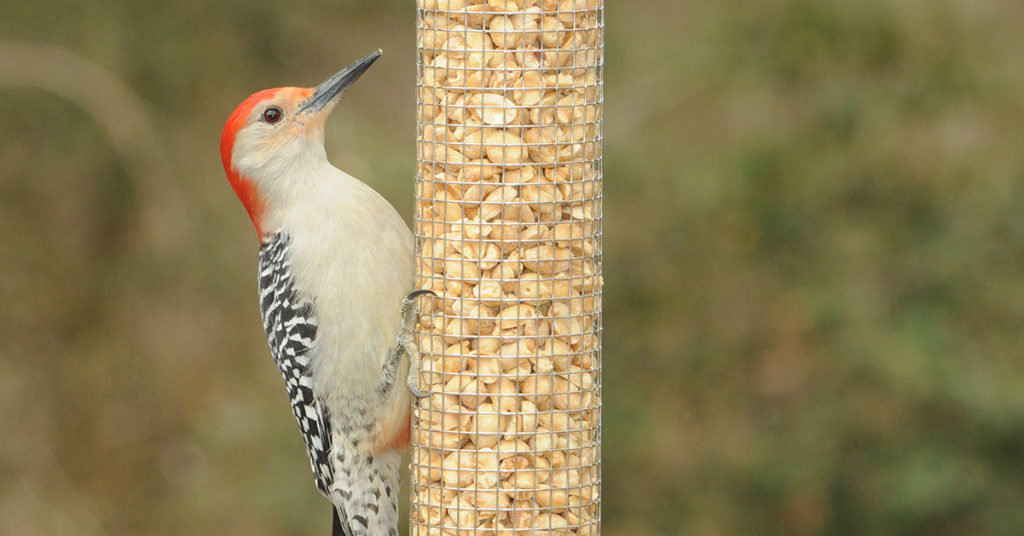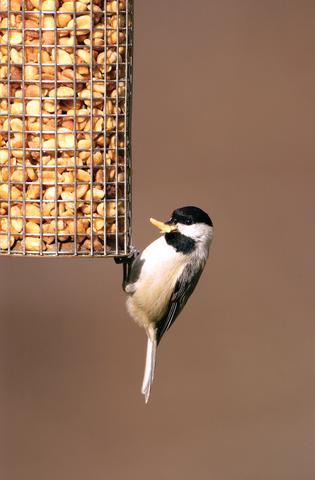from EverythingBirds, sponsored by Droll Yankee, 6/16/2020, Melissa Mayntz

Peanuts are a fast, easy, and surprisingly nutritious food for many backyard birds. Offering birds peanuts in your yard is a great way to attract more species and broaden the appeal of your bird-friendly buffet.
Why Peanuts Are Great for Birds
Peanuts are naturally high in fat. Fat provides abundant energy for all a bird’s daily activities—flying, preening, protecting the nest, nurturing hatchlings, singing, and more. High-fat foods like peanuts are especially critical during the winter or in spring and fall cold snaps. Birds require extra calories to maintain their body heat in the cold. Yet peanuts also provide fiber as well as calcium, potassium, and other nutrients as part of a bird’s well-rounded diet. These nuts do not spoil as quickly as other high-fat feeding options such as suet. Plus, they are relatively affordable for budget-conscious birders.
Birds That Eat Peanuts
A wide range of birds readily snack on peanuts. Particularly, birds that remain in the same ranges year-round and can take advantage of this excellent winter food source. Different birds that eat peanuts include: Cardinals, Chickadees, Crows and Doves, Grackles, Jays and Nutches, and of course, Titmice, Woodpeckers and Wrens. All of these birds will readily eat peanuts. Even other birds such as quail, sparrows, towhees, and turkeys may sample the nuts if they are readily available. Which birds will eat peanuts will also depend on what other food sources are nearby, and what type of peanuts (whole, shelled, chips, etc.) are offered.

Offering Peanuts to Birds
There are many options for offering peanuts to hungry backyard birds. Whole, in-shell nuts are ideal for larger birds such as jays, crows, grackles, and larger woodpeckers. Smaller birds such as chickadees and titmice will prefer peanut hearts or chips that are already broken up. These small pieces are easier for their smaller bills. It isn’t unusual, however, for a small bird to make off with a large prize, taking a whole peanut to a nearby branch to break it open and feast on the nut meats. You can even offer peanut butter to birds! Both crunchy and smooth varieties will be equally enjoyed by feathered guests.
The peanuts you should never offer to birds, however, are those that are designed for human tastes. No seasoned, salted, smoked, or candy-coated peanuts are suitable for birds. The spices and seasonings can be unhealthy or even dangerous for birds to consume. Similarly, no baked goods or other sugary treats should be shared with birds.

The Best Bird Feeders for Peanuts
It is easy to offer peanuts to birds in the yard. You can simply sprinkle or scatter a handful of nuts on the ground for birds to find. Tray and dish feeders can hold all types of peanuts, and there are also specialized peanut feeders that feature wider mesh or holes for peanuts to fit. Peanut butter or peanut-flavored suet can also be smeared directly on trees, offered in classic suet feeders, or used to fill holes in log-style feeders.
While peanuts, particularly whole, in-shell nuts, are a more durable food, they can still spoil and become moldy or rancid in a few days. This is especially true in extremely hot or humid climates. It is best to only offer a few peanuts at a time, and take steps to keep them dry in rainy areas. Squirrels, chipmunks, and raccoons will enjoy peanuts just as much as backyard birds. Be sure to use baffles and other techniques to prevent these raiders from getting all the nuts before birds have a chance to enjoy the treat.

Watching Birds With Peanuts
Once you’ve started feeding birds peanuts, you’ll be entertained for hours by their antics. Birds will work furiously to get peanuts out of specialized feeders, and you’ll be amazed to see even small birds deliberately work at a nut to break off smaller chunks they can easily swallow. Larger birds may wrangle multiple nuts in their bills at once, and birds will even pick up and “weigh” different nuts to select just the right peanut for their snack. Some birds will cache peanuts, meticulously burying each nut in the yard to save their stash for a day when other foods may be scarce. You can even hide peanuts yourself in different spots throughout your yard and garden and wait to see which birds find them first.
No matter what types of peanuts you offer or what birds take advantage of your generosity, feeding birds peanuts is a treat—for both you and the birds!

